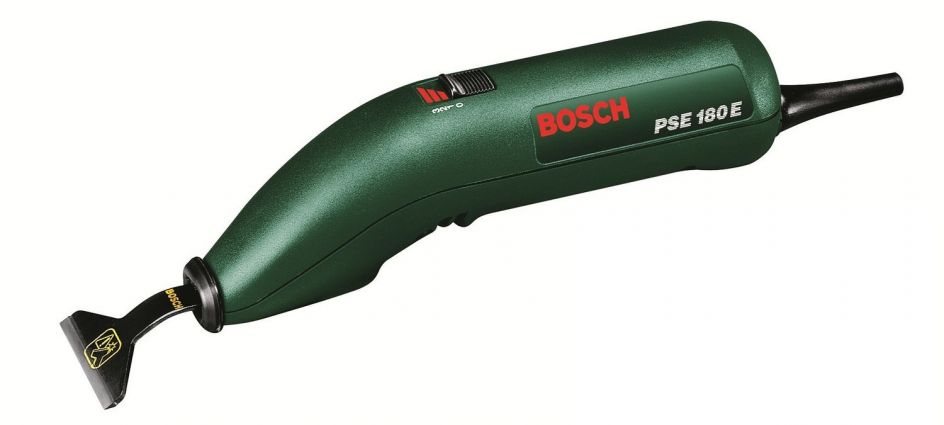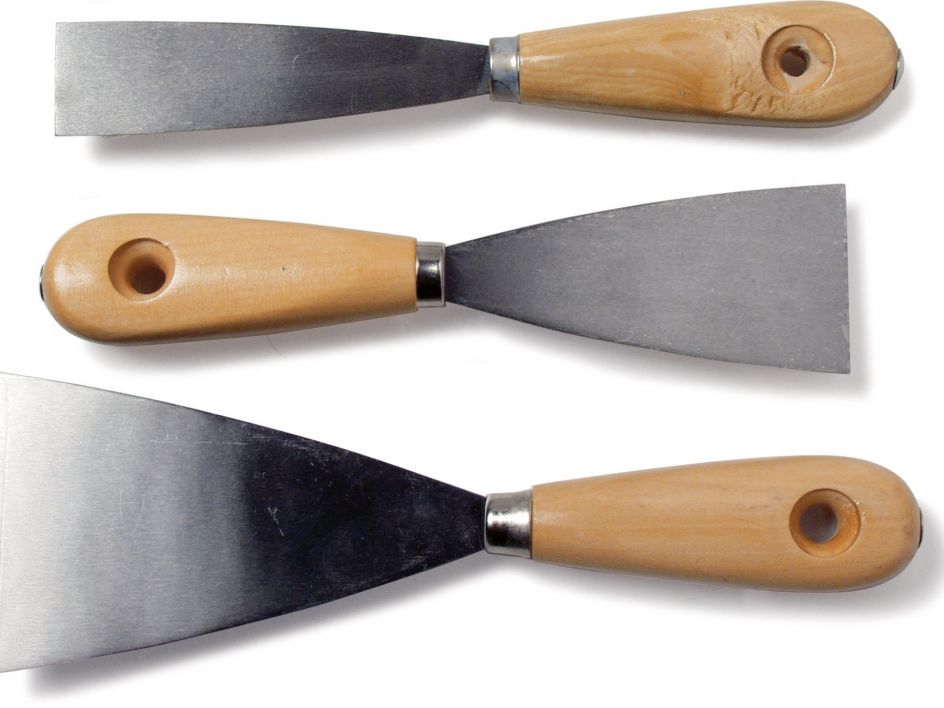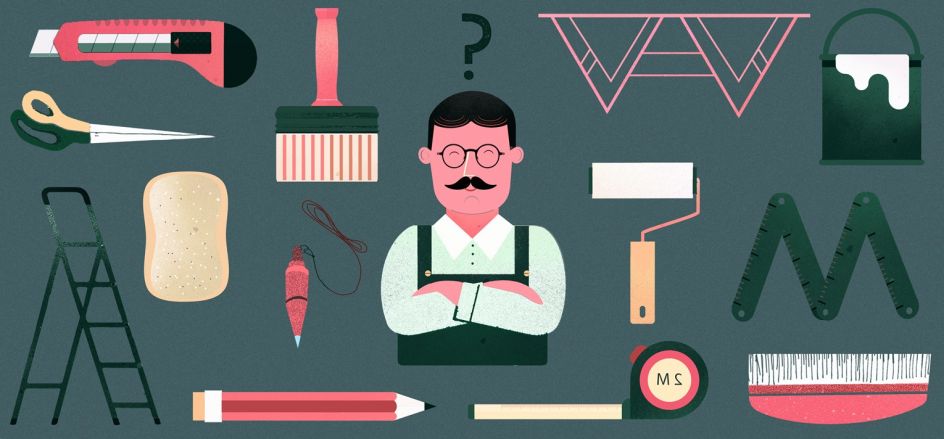Before you can put your lovely new wallpaper up, you will most likely have to strip the old one first. And that can be a really taxing and frazzling process. If you happen to live in an older building, you might be confronted with a few layers of paper-based wall décor, and/or paint remnants, all of which need to be removed.
Wallpaper scrapers and paint spatulas are both suitable for "easier" cases and are a good tool for removing wallpaper and paint. For more stubborn wallpaper and paint remnants, a steam cleaner might be an option.
Professional painters and decorators usually prefer the classic painter's spatula with a conically shaped stainless-steel blade and a wooden or plastic handle. For DIY fans who do their own wallpapering, the wallpaper scraper might be more useful. Which tool is best for your requirements is your decision, but both will deliver good results if used correctly.
Wallpaper scraper models
Wallpaper scrapers are available as manual or electronic models. Both tools aren't just suitable for scraping wallpaper and paint off walls, but also to remove glue and adhesive or other stubborn stains on glass, floors or tiles.
Manual Wallpaper scraper
Manual wallpaper scrapers look similar to disposable razors or ice scrappers for car windows. They are made of metal and have a rubberised handle. The tool has a blade holder for replaceable rectangular blades. The length varies from 20 cm - 60 cm; some models come with a telescopic handle. The blades are between 10 and 15 cm wide. Manual wallpaper scrapers come in a variety of weights - a significant factor in terms of handling. The shorter models with blades of 10 cm width are about 150 to 250 g, whilst the larger models can weigh up to 500 g. Prices for these scraping tools vary between 5 and 20 Pounds.

The blades have to be replaced once they are too blunt to do a good job. Replacement blades can be purchased for about 2 - 4 Pounds (for 10 blades). In order to replace the blades, there are one or two screws on the blade holder. Also available are blades with a blunt side to remove larger bits and a sharper side for more intricate work.
Some wallpaper scrapers are made of plastic. They are obviously cheaper, but are at an increased risk of breaking. In addition, there is a number of disposable models where the blade cannot be replaced. We would strongly discourage you from purchasing these, as it would simply be a false economy. And if the blade of one of the cheap models turns out to be blunt, it's even more annoying.
Electric wallpaper scrapers
Electric wallpaper scrapers, also known as electric wallpaper spatulas, are a multi-functional tool for many areas of application. They can remove a large number of materials and can also be used as carving or smoothing tools. They run via a power cable. At the heart of this tool is the engine with a rated power of 200 - 250 Watt. Electric scrapers can be equipped with various attachments like spatulas, knives or chisels. These elements are locked into place or inserted and can easily be swapped around.

Using an electric scraper saves a lot of energy and elbow grease and speeds up the process of removing wallpaper (and other materials), but as they weigh in at about 1 kg, one does need some physical strength. When used over a longer period of time, the arm holding the device can get quite tired. Furthermore, they obviously use a small amount of electricity - but compared to the alternative (exhausting scraping by hand), it seems a small price to pay.
Most high-quality electric scrapers come with a variety of speed settings, from "controlled" to fast. Prices for these tools are between 70 and 200 Pounds, and they often come with the first set of attachments. Individual attachments can be re-purchased depending on requirements and devices.
Where and how to use your wallpaper scraper
Both manual and electric wallpaper scrapers can be used to remove wallpaper as well as paint. For paper-based wallpaper, it is usually the carrier layer that is stubbornly refusing to come of the wall with the rest of the wallpaper and thus can only be removed in small bits. These wallpaper remnants are first soaked in a solution of warm water and washing-up liquid. For thicker or structure wallpapers, spiked rollers might have to be used to perforate the material and enable the liquid to penetrate and soften the wallpaper paste (see our instructions under How to strip old wallpaper). After a short soaking time, the wallpaper scraper can do its magic. Always begin at the edges as they often come off the wall first, and then work towards the middle. The blade is put on the wall at a sharp angle and the tool is then carefully pushed forward. The main advantage of a wallpaper scraper is that the sharp blade can get under the wallpaper remnants more easily than a painter's spatula.
If you have never used a wallpaper scraper, it might take a little while to get a feel for the process. However, if it is a good quality tool, getting used to it is much easier. In contrast to a painter's spatula, the scraper requires less pressure, which decreases the danger of damage to the wall (provided that the blade is used correctly). An electric device does the scraping for you, BUT you need some strength to hold it for a longer period of time.
Painters' spatulas and shear scrapers
Traditionally, painters' spatulas come with a conical stainless steel blade and a short wood or plastic handle and are available in various blade widths and handle lengths. The main difference is the way they are used. Sharp blades (as those of wallpaper scrapers) immediately signal one thing: Be careful! As for painters' spatulas, their use requires some pressure, which can lead to unintended damages to the wall surface. These will then have to be dealt with and repaired, which often means painstakingly detailed work.

However, the advantages of painters' spatulas are obvious: Once purchased, it can be used for a lifetime, unless it is somehow damaged or stored in a damp environment (but even a stainless steel blade will eventually succumb to humidity). In other words, the spatula will not cause any future cost, unlike the wallpaper scraper with blades. It's light and feels comfortable in the hand, and using it is very simple. But what it really comes down to is personal preference.
For those who cannot do without the painters' spatula, there is also the option of the shear scraper, which is another part of a painter & decorator's toolkit. It has a conical but slightly curved steel blade (blades come in a variety of widths). The curve makes removing material easier, which is especially handy for thicker wallpaper or paint remnants. Even with rigorous use, these tools are very efficient at avoiding damages to the wall surface.
Shear scraper with blade
On today's market, it isn't always easy to keep up with changes, and much of the terminology is open to interpretation. Just like wallpaper scrapers, shear scrapers can come with replaceable blades. They have a very short plastic handle and the blade is about 10 cm wide.

Shear scrapers with blades combine the advantages of wallpaper scrapers with those of painters' spatulas. Just like with painters' spatulas, there is a certain radius that shear scrapers can cover, whereas a wallpaper scraper with a long or telescopic handle enables you to work even on areas that are high up.
Conclusion
The choice of tool for stripping wallpaper is down to personal preference. The most important aspect is that you can work quickly and efficiently. If in doubt, try it out! Because only after testing various options will you be able to make a fact-based decision. Generally speaking, all the tools mentioned above are suitable for the task of removing wallpaper and have a proven track record of successful results.



